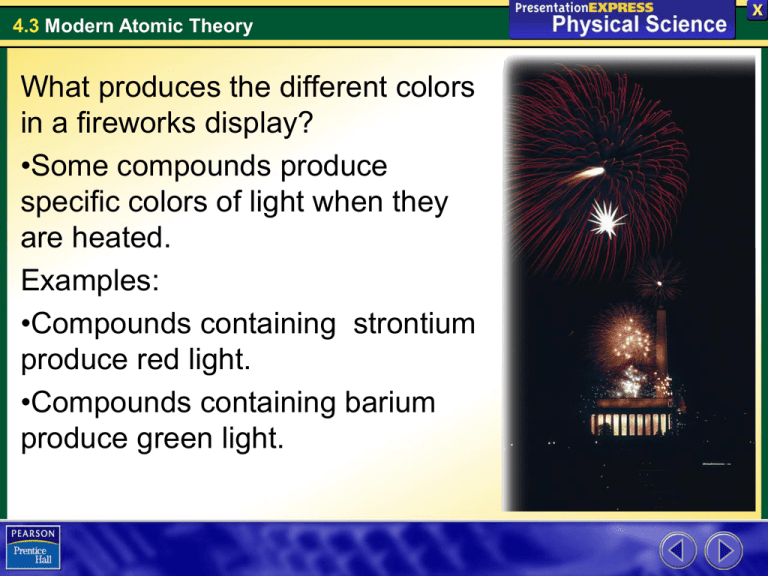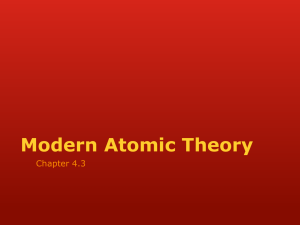Modern Atomic Theory: Bohr & Electron Cloud Models
advertisement

4.3 Modern Atomic Theory What produces the different colors in a fireworks display? •Some compounds produce specific colors of light when they are heated. Examples: •Compounds containing strontium produce red light. •Compounds containing barium produce green light. 4.3 Modern Atomic Theory Bohr’s Model of the Atom Bohr’s atomic model (1913): •Nucleus surrounded by a large volume of space – (like Rutherford's model of 1911) •Focused on the arrangement of electrons. – Electrons move with constant speed in fixed orbits around the nucleus, like planets around a sun. – Each electron in an atom has a specific amount of energy. 4.3 Modern Atomic Theory Bohr’s Model of the Atom Atom gains or loses energy Electron(s) moves between energy levels Electron Electrons gain or lose energy when they move between fixed energy levels Nucleus Bohr Model 4.3 Modern Atomic Theory Bohr’s Model of the Atom Analogy: electron energy levels like a staircase • The landing at the bottom of the staircase is the lowest level. • Each step up represents a higher energy level. • The step height represents an energy difference between levels. • You can only move in whole numbers – you can’t go up half a step 4.3 Modern Atomic Theory Bohr’s Model of the Atom Electron can: •Move up or down (i.e. gain or lose energy) •Move one or more energy levels at a time – if it gains or loses the right amount of energy. •Size of jump amount of energy change (gained or lost) Each element has unique set of energy levels 4.3 Modern Atomic Theory Bohr’s Model of the Atom Light is a form of energy It can be observed/measured. It can be emitted or absorbed by electrons Absorb energy move to a higher energy level Release energy move to a lower energy level 4.3 Modern Atomic Theory Bohr’s Model of the Atom The movement of electrons between energy levels explains the light you see when fireworks explode. • Heat causes some electrons to move to higher energy levels. • When those electrons move back to lower energy levels, they release energy. • Some of that energy is released as visible light. • Different elements emit different colors of light because each element has its own unique set of energy levels. 4.3 Modern Atomic Theory Electron Cloud Model Describes possible locations and energy levels of electrons around the nucleus. Electron cloud: – Visual model – Most likely locations for electrons 4.3 Modern Atomic Theory Electron Cloud Model Electron cloud model replaced Bohr's model of electrons moving in predictable paths. The nucleus contains protons and neutrons Electron Cloud Models The electron cloud is a visual model of the probable locations of electrons in an atom. The probability of finding an electron is higher in the denser regions of the cloud. 4.3 Modern Atomic Theory Electron Cloud Model Bohr’s model was improved [scientists made further discoveries] – Electron “orbits” do have specific energy levels. [Bohr got this part right] – Electrons do not move like planets in a solar system. [Bohr got this part wrong] Electron cloud model: Visual model based on probability (statistical equations) 4.3 Modern Atomic Theory Electron Cloud Model - Analogy: When propeller stopped, you see location of blades. When propeller is moving, you see only a blur. – Blur is similar to drawing of electron cloud. 4.3 Modern Atomic Theory Electron Cloud Model Orbital: – Region of space around the nucleus where an electron is likely to be found. Electron cloud: – All the orbitals in an atom. Electron cloud = good approximation of how electrons behave in their orbitals. 4.3 Modern Atomic Theory Electron Cloud Model - Analogy Imagine a map of our school. •Mark your exact location with a dot once every 10 minutes for one week. •Dots on map are model of your “orbital” – Shows most likely locations to find you. • Places visited most highest concentration of dots. • Places visited least lowest concentration of dots. •Everybody’s dots together = school’s “electron cloud” 4.3 Modern Atomic Theory Electron Cloud Model The level in which an electron has the least energy— the lowest energy level—has only one orbital. Higher energy levels have more than one orbital. 4.3 Modern Atomic Theory Electron Configuration: Ground state: – All the electrons in an atom have the lowest possible energies – Most stable electron configuration 4.3 Modern Atomic Theory Lithium atom (Atomic # = 3) has three electrons. Ground state: – Two electrons in lowest energy orbital; – Third electron in next (second) energy level. Excited state: •Atom absorbs energy Electron moves to higher orbital, leaving “hole” in lower orbital •Excited state less stable than ground state, so •Electron in higher energy level loses energy falls into “hole” •Atom returns to the ground state. 4.3 Modern Atomic Theory Electron Configurations The ground state of a person is on the floor. A gymnast on a balance beam is like an atom in an excited state—not very stable. When she dismounts, the gymnast will return to a lower, more stable energy level. 4.3 Modern Atomic Theory Assessment Questions 1. According to Bohr’s model of the atom, which of the following can happen when an atom gains energy? a. b. c. d. An atom returns to its ground state. A neutron can be changed into a proton. A proton can move to a higher energy level. An electron can move to a higher energy level. 4.3 Modern Atomic Theory Assessment Questions 2. How does the modern atomic theory describe the location of electrons in an atom? a. Electrons move randomly in space around the nucleus. b. Electrons can be described as a cloud based on probable locations. c. Electrons orbit the nucleus in the same way that planets orbit the sun. d. Electrons move in a spiral pattern if increasing distance from the nucleus. 4.3 Modern Atomic Theory Assessment Questions 3. What is meant when an atom is said to be in its ground state? a. There is no net charge on the atom. b. The number of protons equals the number of neutrons. c. The atom’s electrons all have the lowest possible energies. d. It is the isotope with the least number of neutrons.







